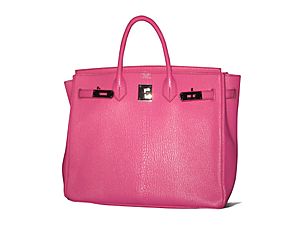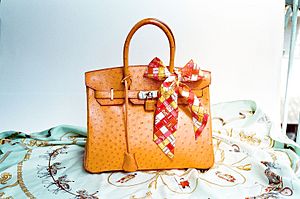Birkin bag facts for kids
The Birkin bag is a special tote bag made by the French company Hermès. It was first introduced in 1984. These bags are handmade from leather and are named after the famous English-French actress and singer Jane Birkin (1946–2023).
The Birkin bag quickly became a sign of wealth and luxury. This is because it has a very high price and used to have long waiting lists to buy one. Many people who collect handbags love Birkins. They were once thought to be the rarest handbags in the world. Their high price makes them very desirable.
In 2020, a regular leather Birkin bag started at about US$11,000. The price can change a lot depending on the type of leather. Bags made from exotic animal skins or with precious metals and jewels cost much more. For example, a bag made of exotic skin with diamonds was sold for a record US$380,000 in 2017! Hermès stores get Birkin bags at different times and in small numbers. This makes them seem even more special and hard to get. However, many Birkin bags are also sold second-hand online or in special shops.
Contents
History of the Birkin Bag

The idea for the Birkin bag came about in 1984. Jean-Louis Dumas, who was the boss of Hermès, was on a flight from Paris to London. He happened to be sitting next to Jane Birkin. Jane's straw bag spilled its contents when she put it in the overhead bin. She told Dumas that she couldn't find a good leather bag for weekend trips.
This meeting gave Dumas an idea. He decided to create a soft black leather bag. It was based on an older Hermès design from around 1900. Jane Birkin used the bag at first. But she later joked that it was too heavy because she put too many things in it! Even so, since the late 1980s, the Birkin bag has become a huge status symbol. It is now easier to buy them from people who resell them.
In 2015, Jane Birkin asked Hermès to stop using her name for the crocodile skin version of the bag. This was because of concerns about how the crocodiles were treated. An animal rights group called PETA said that crocodile farms supplying Hermès kept animals in small, bare concrete areas. Jane Birkin wanted Hermès to make sure their practices were kinder to animals.
Birkin Bag Design Features
Birkin bags come in many different sizes. Each bag can be made special for a customer. They can choose different types of leather, colors, and metal parts. Some bags can even have diamonds on them!
- The bags are made from various animal skins. These include calf leather, lizard, and ostrich. Bags made from saltwater crocodile skin are often very expensive. Bags with smaller scales on the crocodile skin cost more. The inside of each bag is lined with goat-skin. The inside color matches the outside. The price of a Birkin bag depends on the skin type, color, and metal parts.
- Sizes range from 25, 30, 35, to 40 centimeters wide. There are also larger travel bags that are 50 or 55 centimeters wide. Birkin bags come in many colors. Some popular ones are black, brown, golden tan, navy blue, olive green, orange, pink, powder blue, red, and white.
- Every Birkin bag has a lock and keys. The keys are kept in a small leather holder called a clochette. This holder loops through one of the bag's handles. You can lock the bag by closing the top flaps and using the lock on the front. The locks and keys have special numbers. These numbers help identify which group of locks they came from.
- The metal parts on the bag, like the lock, keys, and buckles, are covered with gold or palladium. Adding diamonds is another special option.
- Hermès offers a "spa treatment" for bags. This is a special cleaning and reconditioning service for bags that have been used a lot.
- A "Shooting Star" Birkin bag has a small metallic image of a shooting star. This stamp is next to the "Hermès, Paris Made in France" stamp. It matches the color of the metal parts on the bag.
- You can tell a Birkin bag apart from the similar Hermès Kelly bag by its handles. The Kelly bag has only one handle, but the Birkin bag has two handles.
How Birkin Bags Are Made
Birkin bags are handmade in France. Artisans use a special saddle stitching method that Hermès developed a long time ago. Each bag is sewn by hand by one person. Then, it is buffed, painted, and polished. It can take up to 18 hours to make just one bag! People say that artisans train for five years before they are allowed to make their first Birkin bag. The leather comes from different places in France. This means the leather can have different smells and textures. Hermès says the high cost of the Birkin bag is because of the amazing skill and time put into making each one.
Demand and Value
In 2014, Hermès made about 70,000 Birkin bags. These bags are very wanted. People used to say there was a waiting list of up to six years to get one. Making the bags rare helps to increase how much collectors want them.
Because so many people want them, Birkin bags can be resold for a lot of money. This is especially true in places like Asia. Some people even think of a Birkin bag as an investment. One study found that Birkin bags often increased in value over time. In 2010, Hermès said that the waiting list would no longer exist. This meant the bags might be easier for anyone to buy.
In 2017, a special white crocodile Birkin bag with diamonds was sold at an auction for about US$377,261. This set a new record for the most expensive handbag ever sold.
An expert said in 2019 that there are over one million Birkin bags in the world. Also, one store that resells used Birkin bags sold over US$60 million worth of them in five years. It can still be hard to buy a new Birkin bag directly from Hermès stores. Many people believe you need to have a good relationship with a sales person to get one.
Fake Birkin Bags
Like many famous brands, Hermès Birkin bags can be faked. Some fake Hermès bags were even made by a group that included former Hermès workers. These people were accused of making many fake bags. They sold them for thousands of euros each. The police found out about this while looking into other stolen items. The fake bags were made using Hermès' own stitching methods. The people making them even used stolen leather scraps and tools from Hermès.
See also
 In Spanish: Bolso Birkin para niños
In Spanish: Bolso Birkin para niños
- Conspicuous consumption
- Economic materialism
- Kelly bag
- Social prestige




